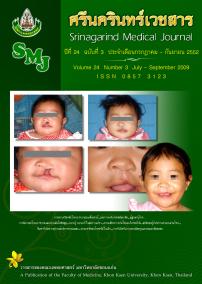ThaiScience
ThaiScience
SRINAGARIND MEDICAL JOURNAL
Volume 36, No. 02, Month MARCH, Year 2021, Pages 127 - 130
Chest wall thickness at a proper area for insertion of intercostal chest drainage
Phati Angkasith, Panu Teeratakulpisarn, Chaiyut Thanapaisal, Narongchai Wongkonkitsin
Abstract Download PDF
Background and objectives: Nowadays, the areas for insertion of tube thoracostomy are mostly applied in the safety triangle area (lateral border of pectoralis major muscle, anterior border of latissimus dorsi muscle and the nipple line). The thicker chest wall may contribute to difficult tube thoracostomy insertion. So, cadaveric chest walls are measured for thickness to confirm appropriateness of safety triangle. Methods: The fresh cadaveric chest wall was measured by the needle tapping the chest wall within the safety triangle combined with sternotomy to determine the thinnest area of the chest wall. The measured values are recorded in millimeters (mm.). The mean thickness of the chest wall, standard deviation (SD), BMI of the cadaver before preparation were studied Results: The 20 fresh cadaveric chest walls were measured for thickness. The mean chest wall thickness within the safety triangle varies between 14.4 mm. to 23.9 mm. The areas with more than 50 mm thickness were mostly found in the mid-axillary line and two cases (54 and 56 mm.) in the 3rd intercostal space crossing with anterior axillary line. While the thinnest areas (14.4 mm.) are found within 7th intercostal space. Most female cadavers have thicker chest wall than male. Conclusion: Some areas in the safety triangle for tube thoracostomy insertion are more than 50 mm. in thickness. The area for insertion of the tube thoracostomy should be carefully selected,especially in woman and the obese patients. Moreover, insertion below 6th intercostal space should be avoided due to risk of peritoneal penetration.
Keywords
chest trauma; intercostal chest drain; tension pneumothorax; chest injurySRINAGARIND MEDICAL JOURNAL
Published by : Faculty of Medicine, Khon Kaen University
Contributions welcome at : http://www.smj.ejnal.com/e-journal/journal/index.php
